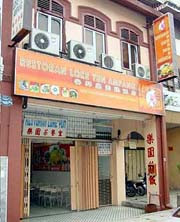The buffet is available from 10.30pm to 2am, priced at RM9.90++ per person. Call 03-2693 9233 ext 8023.
Middle Eastern fare
Crowne Plaza Mutiara Kuala Lumpur is presenting the exotic cuisine of the Middle East at Planters’ Inn.
The Arabic specialties will feature a healthy combination of herbs and spices.
Chefs have prepared well-loved offerings like Hummus, Taboleh, Fatoush, Magdous, Mojhalil, Dajaj Ala El-fahm, Fasolia Nashfah Bil-lahim, Molokhia Bil-jambari, Khodar Mishakel, Kofta Bil-tahina, Samk Ma Khodra and Roz Shakriah.
For desserts, there’s Baklava, Bashusah, Sharin, Khoshaf and Fawakh to name a few.
The buffet lunch is priced at RM69++ while dinner is at RM79++.
Call 03-2148 2322 ext 3820/ 3821
Thorny delights
Crown Princess Kuala Lumpur has durians for diners at Spring Garden Chinese Restaurant.
The Durian Egg Tart and Durian Pancake are available for eat in or take away, priced at RM10++ per serving.
The tart shells are filled with durian custard while the pancake is filled with lovely durian filling. Call 03-2162 5522 ext 5511.
PINK LOTUS VEGETARIAN RESTAURANT, 32 Batu 5, Jalan Ipoh, KL (Tel: 03-6258 9618/016-274 1190 (Cheng). Business Hrs: Daily, lunch (10.30am-3pm); dinner (5.30pm-11pm). Halal. Ingredients used in the vegetarian dishes are guaranteed of quality and nutritional values. The mock fish is made of fuchok, seaweed and taufu.
SODA CAFE, Lot PT4512, Jalan 23/70A, Desa Sri Hartamas, KL (Tel: 03-6201 4029). Business Hrs: Weekdays (11am-midnight); Weekends & Public Hols (11am-1am). A lifestyle café blending food and fashion. Catch fashion shows on the telly or attend the many fashion-related activities.
HIDEKI JAPANESE RESTAURANT, One Bangsar, 63B Jalan Ara, Bangsar Baru, KL. (Tel: 2282 1111) Business Hrs: Daily, lunch (noon-2.30p); dinner (6:30-10.30pm). Offers a unique menu of over 200 dishes created by its master chef complemented with a fine selection of sake, shochu and wine. Weekend Buffet Lunch on Saturdays, Sundays and Public Holidays. Daily Set Lunch and Set Dinner available. Private rooms available for corporate or private functions.
LUDHIANA STATION, 28 Jalan Telawi Dua, Bangsar Baru, KL (Tel: 03-2287 1359). Business Hrs: Daily (8am-midnight). A spacious outlet with a large open kitchen. Serves traditional Punjabi cuisine alongside Western and fusion favourites. Breakfast available.
ZOHARA’S RESTAURANT, 9137 Jalan Bandar 4, Taman Melawati, KL (Tel: 03-4106 9137). Business Hrs: Daily, lunch (11am-3pm); dinner (6pm-11pm). Specialises in Indian and Pakistani cuisine. Signature dishes are Mulligatawny Dum Briyani Mutton/Chicken and Sultani Murgh Massalam.
LUCA’S PIZZA RESTAURANT, G02 & G03, Ground Floor, Wisma diCor, Jalan SS17/1A, Subang Jaya (Tel: 03-5631 0505). Business Hrs: Daily (noon-10pm). Halal. Authentic Italian pizza made with imported ingredients. The 37.5cm pizzas with eight different toppings are sold whole or as quarters. Delivers to offices and residences within the area.
ITALIANNIES, F355, First Floor, Rainforest (New Wing), 1 Utama Shopping Centre, Bandar Utama, KL (Tel: 03-7727 1399). Business Hrs: Mon-Fri (11am-11pm); Sat & Sun (10.30am-11.30pm). Halal. Italiannies quaint ambience is conducive for conversations over traditional Italian fare.
D’ FORTUNE WESTERN CUISINE & CAFE, 83 Jalan Radin Tengah, Bandar Sri Petaling, KL (Tel: 03-9058 7851). Business Hrs: Mon-Fri (11.30am-11.30pm); Sat & Sun (11.30am-midnight). Brings to mind scenes of cowboy movies of yesteryear. D’Fortune offers Western cuisine with a local twist like the D’ Fortune Seafood Spaghetti with Cili Padi. Features a different set lunch menu each day.
WENDY’S BISTRO, 20 Jalan PJS8/18, Dataran Sunway Mentari, PJ (Tel: 03-5630 1699). Business Hrs: Daily (11am-11pm). Non-Halal. Incorporates a deli and bar with an extensive menu to boot. Popular for its variety of pork dishes.
BAKERZIN, G-312, Ground Floor Highstreet, 1 Utama Shopping Centre, Bandar Utama, PJ (Tel: 03-7729 4493). Business Hrs: Daily (10am-11pm). Halal. Styled after a French teahouse and offers Warm Chocolate Cake Strawberry Shortcake and Creme Brulee. There are breads, soups, salads and sandwiches too.
FOOD FOUNDRY BG-8, Happy Mansion, Jalan 17/13, Section 17, PJ (Tel: 03-7955 3855/03-7955 3885). Business Hrs: Daily (11.30am-10pm). Pork-free. The ideal place for a quiet lunch or afternoon tea. Western, Italian and local delights with top points awarded for the Mille Crepe Cake, made of layers of custard-filled pancakes.
RESTORAN KING CRAB, 103-105 Jalan SS25/2, Taman Mewah Jaya, PJ (Tel: 03-7808 2388). Business Hrs: Daily (11am-2.30pm); dinner (6pm-11pm). Non-Halal. Extremely popular so getting a table requires some waiting time. Some dishes need pre-ordering.
ROYAL CHINA BUKIT BINTANG, 239 1st Floor, Jalan Bukit Bintang, KL (Tel: 03-2142 2625). Business Hrs: Mon-Sat, lunch (11.30am-2.30pm); dinner (6.30pm-10.30pm). Sun & Public Hols, breakfast/lunch (10am-2.30pm); dinner (6.30pm-10.30pm). Non-Halal. Known for its unique Thai-Chinese seafood dishes like Baked Lobster with Butter Thai-Style, Baked Crab with Vermicelli in Claypot and Thai Shark’s Fin Soup.
SAYANG RECIPE, 4 Lorong Ara Kiri 3, Lucky Garden, Bangsar, KL (Tel: 03-2094 0662). Business Hrs: Tues-Sun, lunch (11.30am-2.30pm); dinner (6pm-10pm). Pork-free. Serves traditional Penang Nyonya fare based on recipes handed down the generations.
SRI NYONYA RESTAURANT, 14 Jalan 22/49, PJ (Tel: 03-7875 1031). Business Hrs: Tues-Sun, lunch (12.30pm-2.30pm); dinner (6.30pm-9.30pm). Pork-free. The owners’ family recipes like the Sri Nyonya Fried Chicken and Perut Ikan span four generations. Set Lunch available from Tuesday to Friday at RM10nett per person.
H&H RESTAURANT, 31, Jalan SS21/37, Damansara Utama (Uptown), PJ (Tel: 03-7728 5459). Business Hrs: Daily, lunch (11.30am-2.30pm); dinner (5.30pm-9.30pm). Halal. It enjoys a simple decor with basic lighting and neatly arranged red-topped dining tables with a family theme. Food is cooked according to customers’ preference. Also serves noodles and Western dishes, which are prepared to order. Set menus available. Does catering service for all types of functions.
NEW TASTE STEAMBOAT RESTAURANT, 24 Jalan Siput Akek, Taman Billion, Cheras, KL (Tel: 012-386 2855/016-432 2296). Business Hrs: Nightly (6pm-midnight). Non-Halal. Its speciality is steamboat made with bak kut teh, a soup-base flavoured with 15 herbs and spices. Servings come with a variety of seafood, vegetables and other dishes served with homemade dipping sauces.
AI KOPITIAM, 8 Jalan Serunai 1, Taman Klang Jaya, Klang (Tel: 016-348 8633). Business Hrs: Mon-Wed, Fri-Sun (11am-10.30pm). Pork- & Beef-free. Typical coffee shop with large menu featuring local and Asian dishes.
KAFE SAKURA KRISTAL, 301 Jalan Bandar 11, Taman Melawati, KL (Tel: 03-4108 5897). Business Hrs: Mon–Sat (noon-1am); Sunday (4pm-midnight). Halal. Asian, Thai, Western and Malaysian cuisine with enough options for vegetarians too.
THE RANCH CAFÉ, 14 Jalan Anggerik Vanilla Y 31/Y, Kota Kemuning, Shah Alam (Tel: 03-5122 7706). Business Hrs: Mon–Sat (11am-11pm); Sun & Public Hols (6pm-11pm). Halal. Western food and a segment on Mexican favourites with house specials like Tacos and Sizzling Beef Fajitas.
DECANTER 3, 5 Jalan 17/56, PJ (Tel: 03-7968 1300). Business Hrs: Mon-Sat (noon-midnight) / 7 Jalan Setiakasih 5, Bukit Damansara, KL (Tel: 03-2095 2507) / Decanter Too, Prisma Ville Business Centre, Jalan 19/70A, Sri Hartamas, KL (Tel: 03-6203 5448). Business Hrs: Daily (noon-midnight). Halal. Great ambience, prompt service and ample parking. Choose from over 80 Western and local favourites. Popular for its Oxtail Stew and Penang Assam Laksa.

























